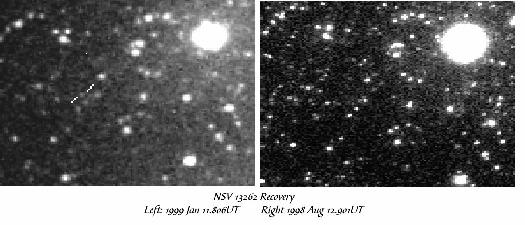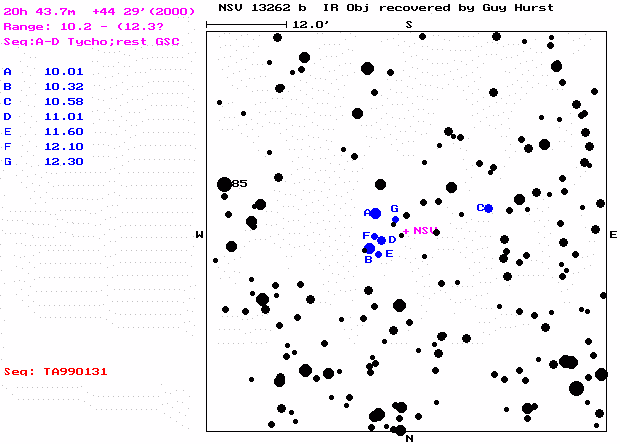
from VSSC99
In July 1998, as part of the UK Nova/Supernova Patrol, I commenced a search for novae using a 50mm lens operating at f1.8 and the Starlight Xpress MX516 CCD camera. The period to December 1998 was largely experimental, without comprehensive checking, but from January 1999, I began checking in the hope I could detect an intruder to magnitude 9, or possibly fainter.
The 5 second exposures can reach magnitude 12 in very good conditions, and cover an approximate field of view of five degrees. On an exposure of the Deneb field, obtained on 1999 Jan 11.81UT, I detected a variable object near Deneb. The star, located at: RA 20h43.7 DEC +44 29 (2000), was of magnitude 10.7, whereas on1998 Dec 28.754UT it was near the limit at 11.6. In response to my e-mail appeal under reference Q1999/003, Steven Foulkes recorded it on 1999 Jan 13.775UT at 10.7 (LX200). Tom Boles also measured the position:1999 Jan 16.738UT as: RA 20h43m40.6s DEC +44 28’38.1"(2000).

Using Guide 7.0 software, it seemed that my suspect was GSC 3178.00545, but I noticed there was also a suspected variable, NSV 13262, plotted further to the south east. This had a catalogued range of 12.3 - 12.6, which seemed too faint for my candidate. However, I decided to make sure, and I traced the original discovery paper for the NSV object entitled ‘Near-Infrared Photometry of Unidentified IRC Stars’ (Lockwood, ApJ., 192, 113L, 1974). This contained a finder from the Palomar Sky Survey, and this confirmed that my suspect, the GSC star and the NSV object were all one and the same. Looking back over unchecked images taken in 1998, in the period 1998 August to 1999 January, there was an apparent sharp brightening on the exposure of 1998 Nov 4.857UT to magnitude 10.2, whereas on 1998 August 12.901, the object was not recorded to a limit of 12.3. Even allowing for the possibility that it was bright due to the spectral response of my equipment, and the very red nature of the object, it does seem to have a substantial amplitude compared with the NSV catalogued range of 12.3-12.6. Figure 2 shows a new chart and sequence, from which I hope some readers will obtain and submit estimates to me. Figure 1 shows a comparison of CCD images, which I would stress are highly magnified, and therefore do show rather fuzzy images for which I apologise. I am still learning the art of CCD work!
